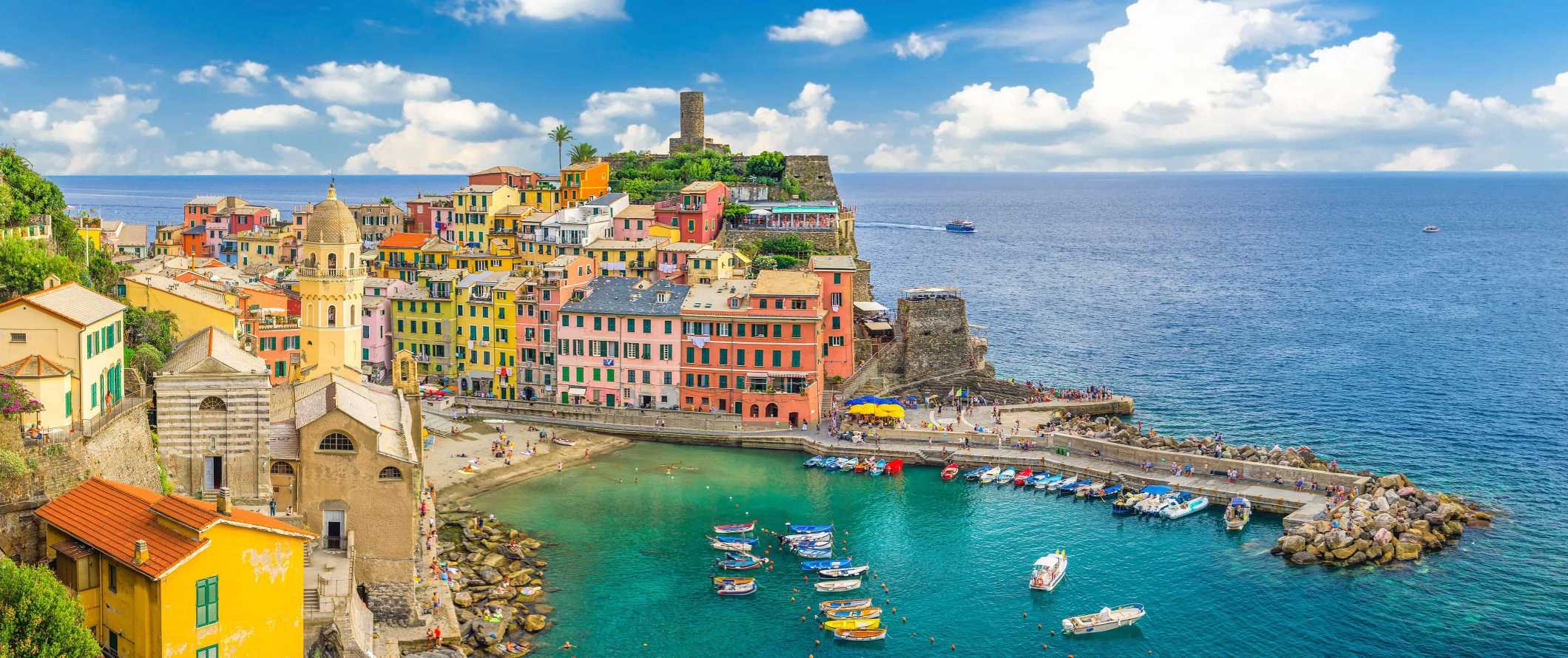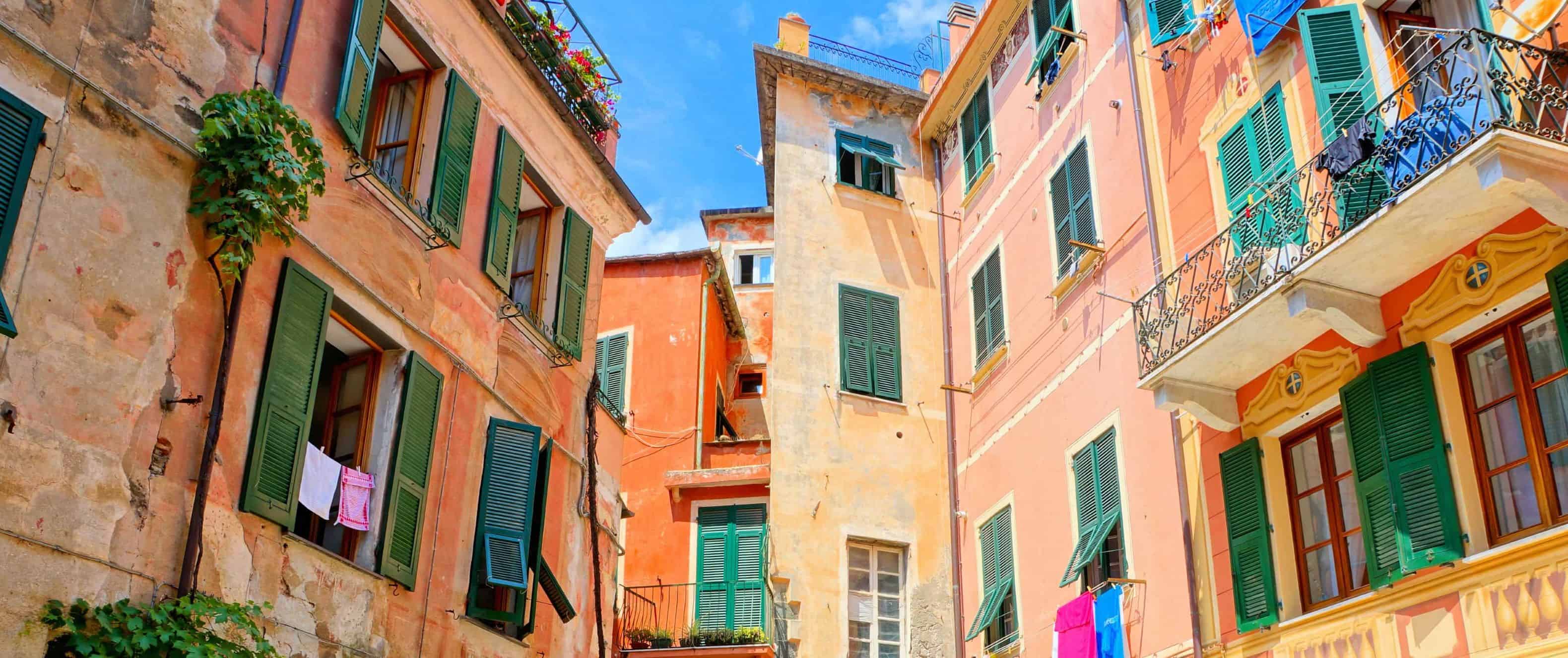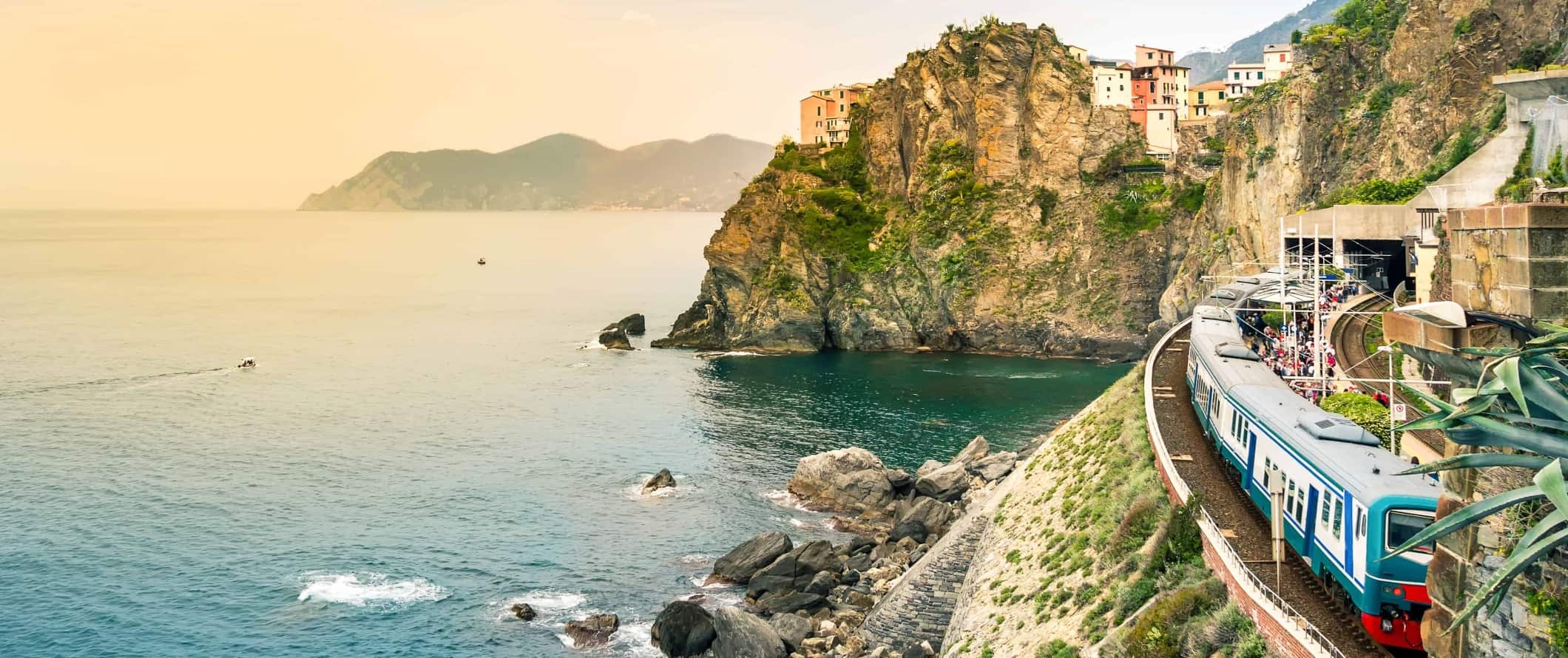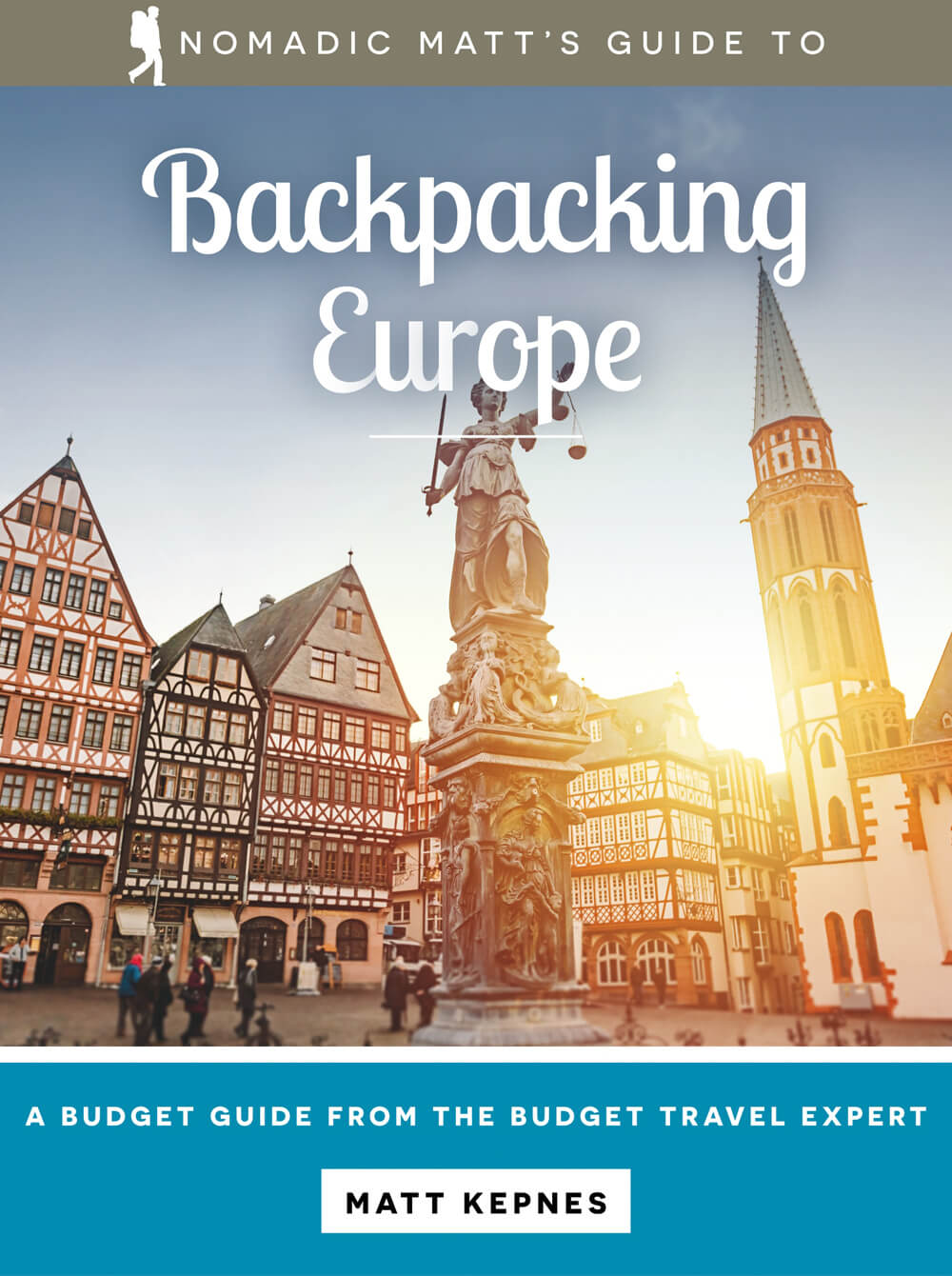Cinque Terre Travel Guide

The Cinque Terre consists of five beautiful hillside towns on the west coast of Italy: Riomaggiore, Manarola, Corniglia, Vernazza, and Monterosso. Together, these fishing towns comprise Cinque Terre National Park, a UNESCO World Heritage Site and one of the most visited regions in the country.
From looking inside Manarola’s Church of San Lorenzo to hiking down from the vineyards into one of the colorful towns, every second in Cinque Terre is Insta-worthy and postcard-perfect.
Best of all, there are plenty of nature walks, trails, and vineyards in the surrounding area that make it possible to explore Cinque Terre without breaking the bank. Just keep in mind the towns are small and they get very, very crowded during peak summer months.
This Cinque Terre travel guide can help you plan an awesome and affordable trip to this stunning region of Italy.
Click Here for City Guides
Top 5 Things to See and Do in Cinque Terre

1. Hike the Cinque Terre
Most travelers say that you need to hike the Cinque Terre in order to really appreciate it. I agree. The coastal walk (blue trail) is the easiest and the best way to see the towns. The full walk is about 12 kilometers (7.5 miles) with roughly a 600-metre elevation (1970 feet), though you can choose to just do certain sections. The most famous bit, Via Dell’Amore (or Lover’s Lane), connects Riomaggiore and Manarola and is currently closed due to restorations. It won’t fully reopen until July 2024, when access will be restricted (you’ll need to join a guided tour to visit). You must have a ticket for the blue trail as there are checkpoints when entering each village. The Cinque Terre Trekking Card costs 7.50 EUR for one day, or 18.20 EUR including unlimited travel on the Cinque Terre Express train between the villages. If you want something more difficult, there are many other always free trails that go through the steep hills and vineyards.
Guided full-day hiking trips are also available if you’d prefer to have an expert local guide show you around.
2. Catch the sunset or sunrise
The views of the sea from the trails and colorful villages are only made more epic during sunset and sunrise. If you can get up early for sunrise, you’ll also enjoy the added benefit of quieter towns, trails and beaches before all the tourists arrive. As all the towns have the sea to the West of them, there are tons of stunning sunset spots to discover along the trails and beaches as well as restaurants and bars with the perfect spot to enjoy a view and an aperitivo.
Sunset boat tours are also plentiful here, generally costing 70-85 EUR, including an aperitif and the chance to stop at one of the several beaches or coves for a swim.
3. Visit Torre Guardiola
Formerly part of the fortress of the Italian Royal Navy, Torre Guardiola is now a bird-watching and nature observation center with conference facilities and its own restaurant. It’s located just southeast of Riomaggiore on Fossola Beach, next to a bar. There’s also a beautiful trail that leads down to a great swimming spot. Admission is 1.50 EUR. It’s closed during winter.
4. Go swimming
The Mediterranean’s cool blue waters are a perfect place to go swimming, especially during the hot summer (just stay close to shore). Keep in mind that most beaches here are rocky rather than sandy, with Monterosso being the exception. Head to Fegina beach right across from the Monterosso train station, or the old town beach just where the trail to Vernazza begins. Manarola is rocky and doesn’t have an official beach but the sheltered harbor is a sweet spot for a swim or snorkel in the (quite deep) clear water.
During the Italian holidays (in August), the beach areas get very crowded so be sure to arrive early. Many beaches have paid and private sections, with the ability to rent umbrellas and lounge chairs.
5. Visit the churches
Every town along the Cinque Terre has its own collection of churches which vary in age (from the 13th to 17th centuries) and architectural style. Be sure to visit the Gothic-style Church of San Lorenzo (Manarola), the seafront Santa Margherita di Antiochia Church (Vernazza), or San Pietro (Corniglia) with its Baroque elements. Entrance to the churches is usually free though you’ll want to dress respectfully as they are places of worship. Most of them are named after a saint and there will be a day to honor each one every year – cue festive lights at the church, games, fairs and stalls selling local food and sometimes even a procession through the town’s streets like for the Feast of San Lorenzo (August 10th).
Other Things to See and Do in Cinque Terre
1. Go kayaking
Being on the water makes the views here all the more majestic. The cliffs feel more dramatic, the colors more intense, and the water seems a deeper shade of blue. It’s a very different way to see the five towns. Rentals start at 10 EUR per hour or 50 EUR per day and can be done from any of the towns in the area. You can also take a guided kayaking tour, with half-day tours starting at 85 EUR.
2. Have an authentic Ligurian beach picnic
Grab yourself a basket and shop around town for some local goodies. There are some great little restaurants that serve fresh, hot focaccia and there are plenty of cheap local wines available too. Grab some food and drinks and head to one of the beaches, where you do as the locals do and eat, swim, and be merry.
3. See the Nativity in Manarola
If you happen to be visiting between December 8th and the end of January, this scene is worth a quick visit. The Nativity Manarola is the world’s biggest lighted nativity scene, and its opening ceremony is a huge event. Started in 1961 by a former railway worker, the scene contains more than 300 life-size figures lit up with over 17,000 lightbulbs. Many locals also come out and light candles. It’s free and best seen from the square of the church of San Lorenzo or for a closer look, on the via Beccara trail (it’s a bit of a hike up over 300 stairs though!).
4. Go camping
Spring through early fall is a beautiful time to go camping (or glamping) here. There are a few campgrounds to choose from that offer inexpensive tent set-ups that can cut your accommodation costs while giving you a chance to embrace the natural scenery here. Camping Acqua Dolce is a popular choice near the town of Levanto (it’s close to the beach too). A basic campsite costs 15-20 EUR per night in the shoulder season and most have room for campervans and parking available for cars.
5. Explore castle ruins
In Monterosso, you can visit the ruins of a 16th-century castle which was built as a defense fortification after a Saracen (Arab Muslim) attack. The castle once included a monastery, a watch post, three town gates, and 13 towers. Now the ruins consist of three circular towers and a square tower that lie near the cemetery on San Cristoforo Hill.
In Riomaggiore, the 13th-century Castello di Riomaggiore is perched at the top of the town’s historic center. Only the tower and a few buildings remain, but it’s just a short walk from town and offers beautiful views over the town and the water. It’s free to wander around and 2 EUR to enter. From time to time there might be an exhibition on inside displaying an aspect of the area’s culture too.
6. Run the Schiacchetrail Ultra Marathon
Every year in late March a few hundred runners take on a challenge along ancient mule trails through the vineyards and fields between Riomaggiore and Monterosso. Participants run either a 47 or 100 Kilometer (29 or 62 Mile) trail with a 2600 Meter (8530 foot) elevation. Registration opens in October with athletes running the 47 Kilometers being chosen via lottery draw months before.
Named after the dessert wine Cinque Terre is best known for producing, Sciacchetrà, this race is a grassroots community effort aimed at preserving and boosting agriculture in the region. If you haven’t trained quite enough to run the trail, indulge in the 3 days of events around the race like pasta parties, wine tastings and traditional games.
7. Learn about Italian naval history
The Technical Naval Museum is the world’s oldest naval museum. It’s located next to a major Italian naval base in La Spezia, the gateway city to the region. The collection takes up two levels and contains a lot of information on the region’s naval history including an area dedicated to Marconi, the man who developed the first wireless telegraph over sea. There are also all kinds of artifacts, including old diving suits, ship replicas, anchors, and more. The museum is open 7 days a week until 7:30pm and admission is 1.55 EUR. Give yourself at least 2 hours to experience the exhibits – naval enthusiasts will probably spend even more.
8. Go wine tasting
This region is home to some great wine, so if you get thirsty and need a break from hiking, take a wine tour! You’ll learn about the unique grape-growing qualities of this area while tasting locally produced wines. Local wines from Cinque Terre are mostly dry white wines that pair excellently with the abundance of fresh fish and seafood in the area. While some restaurants will hold a tasting and food pairing on site, others can include a walk (or hike) to the vineyard itself as part of the experience.
Tours vary in length and price, but a vineyard tour with Get Your Guide costs around 75 EUR.
9. Check out Chiesa di Santa Margherita
The picturesque harbor of Vernazza has a waterfront piazza that’s a great spot for people-watching and taking a break. The Gothic church, Santa Margherita di Antiochia, can also be found here. Originally built in 1318, it was supposedly built when Santa Margherita’s bones washed up on the town’s shores — twice. The church’s unique octagonal, domed bell tower is still intact and offers great views over the harbor.
10. Hang out in the villages
Each of the five villages has a slightly different flavor and vibe. They range in size from Monterosso al Mare, the largest and home to the only sandy beach, to Corniglia, the smallest and perched high on the cliffs. If you have the time, it’s worth spending a little more time in each soaking up the atmosphere. The Cinque Terre express train makes it super easy to pop around to the different villages.
How to Stay Safe in Cinque Terre
The Cinque Terre is an incredibly safe place to visit as violent crimes are incredibly rare here. That said, scams and pickpocketing can occur, although they’re much less of an issue in this region than elsewhere in Italy. Nevertheless, always keep your items secure and out of sight when in public.
If you’re worried about getting scammed, you can read about common travel scams to avoid here.
Solo female travelers should feel safe here, however, the standard precautions apply (never leave your drink unattended at the bar, never walk home alone intoxicated, etc.). There are numerous solo female travel blogs that can provide more specific tips.
Some of the hiking trails can be steep and slippery so watch your footing. Bring proper footwear with a good grip and be aware that these trails are challenging for those with mobility issues. Stick to designated hiking trails and avoid veering off onto unauthorized paths, as this can lead to accidents or getting lost, especially in rugged terrain. Carry an adequate supply of water (especially if hiking during the summer), wear sunscreen, and check weather conditions before you set out on a long hike. As it’s a coastal area, weather conditions can change rapidly, so be prepared.
If you plan to swim, stick to designated swimming areas that are monitored by lifeguards, if you can. Never swim alone, especially in unfamiliar waters. Pay attention to warning flags and signs posted at beaches, and always follow the advice of lifeguards. Avoid swimming in restricted or dangerous areas with strong currents or rocky bottoms.
If you experience an emergency, dial 113 for assistance.
Always trust your gut instinct. Make copies of your personal documents, including your passport and ID.
The most important piece of advice I can offer is to purchase good travel insurance. Travel insurance will protect you against illness, injury, theft, and cancellations. It’s comprehensive protection in case anything goes wrong. I never go on a trip without it as I’ve had to use it many times in the past. You can use the widget below to find the policy right for you:
Where to Stay in Cinque Terre
When choosing a place to stay in the Cinque Terre, make sure you’re located somewhere with easy access to the five towns. My recommended places to stay are:
- 5 Terre Backpackers (La Spezia)
- Ostello Corniglia (Corniglia)
- Hotel Della Baia (Portovenere)
- Viadeibanchi (Riomaggiore)
- 3 Terre Pelagos (Manarola)
Cinque Terre Travel Costs

Accommodation
- Hostel dorms – 25-45 EUR per night
- Hostel private rooms – 75 EUR per night
- Budget hotels – 100-125 EUR per night
- Airbnb private rooms – 60 EUR per night
- Airbnb apartments – 100 EUR per night
- Campsite – 15-20 EUR per night
Food
- Street food – 3-8 EUR
- Sit-down restaurants – 25-40 EUR
- Casual take-out places – 6-10 EUR
- Beer – 5 EUR
- Glass of wine – 3-4 EUR
- Cappuccino/latte- 1.50-3 EUR
- Cocktails – 7-8 EUR
- Groceries for a week – 60-70 EUR
Cinque Terre Suggested Budgets
Backpacker – 65 EUR Per Day
You’ll be staying in a hostel dorm, cooking all of your meals, and taking public transportation to get around. You’ll need to limit your drinking and stick to mostly free activities like hiking and enjoying the beach. If you plan on drinking, add 5-10 EUR to your daily budget.
Midrange – 175 EUR Per Day
On a mid-range budget, you can stay in a budget hotel, a private room in a hostel, or an Airbnb. You’ll be able to eat out (on the cheap) for some meals, enjoy a few drinks out, take the train between towns, and do more paid tours and activities.
Upscale – 300 EUR Per Day
On an upscale budget, you can eat out for all your meals, drink more, get an unlimited train card, and do whatever tours and activities you want. The sky is the limit!
Cinque Terre Travel Guide: Money-Saving Tips
Cinque Terre is one of the most popular places to visit in Italy, especially during the summer. Thus, it’s not that cheap. Accommodation and food will really be the bulk of your spending here. Here are my tips for saving money in Cinque Terre.
- Go hiking – The hiking trails are the best and cheapest way to see the area. Besides a couple of paid trails, hiking is a free activity that takes up most of your day. Additionally, it’s free to sit on the beach.
- Eat pizza and paninis – Sit-down meals here are very expensive. Stick to cheap sandwiches and pizza if you want to save money. Picnics from grocery stores in town made up of fresh pesto, cheese, and focaccia are the way to go!
- Get the Cinque Terre Card – This card includes access to all the paid hiking trails, shuttle buses, and Wi-Fi for 7.50 EUR per day. You also can get the Cinque Terre Train Card, which includes all of the same perks but with unlimited train travel around Cinque Terre for 19.50 to 32.50 EUR, depending on the season.
- Pass on the bread – Some restaurants here charge extra for bread but won’t tell you about it until the bill arrives. Send it back when it comes if you don’t want to be tempted.
- Buy lots of wine – You can buy a great bottle of wine at the store for around 5 EUR. It’s a lot cheaper than drinking at the bars.
- Drink the tap water – Ask for tap water at restaurants or you’ll automatically get expensive bottled water included on your bill.
- Stay with a local – Accommodation is expensive in Cinque Terre. Use Couchsurfing to stay with locals who have extra beds and couches for free. You’ll save money and get to connect with locals who can share their insider tips and advice.
- Bring a water bottle – The tap water here is safe to drink so bring a reusable water bottle to save money and reduce your plastic use. LifeStraw is my go-to brand as their bottles have built-in filters to ensure your water is always clean and safe.
How to Get Around in Cinque Terre

Hiking – Trails connect all the towns but they vary in difficulty so bring sturdy footwear. Personally, I love to hike between the five towns and then take the train back to my accommodation for a rest.
If you plan on just hiking between towns, you can purchase a Cinque Terre Card for 7.50 EUR per day. If you want a more inclusive ticket, it costs 19.50 EUR in the low season to 32 EUR in the summer for a ticket with unlimited access to the trains and buses as well. It also includes free and discounted entry to a few museums.
Train – A train connects all five towns, as well as La Spezia and Levanto (which are located at both ends of the Cinque Terre). Single tickets cost 5-8 EUR each way, so if you’re planning on traveling a lot between towns, you’re much better off getting the Cinque Terre Card (see above). If you decide to ride the train, make sure you have your ticket because the authorities give a hefty fine if they catch you without one.
Bus – There is no public bus connecting the towns in the Cinque Terre, but each village has its own bus that takes you to specific destinations. For example, the bus in Riomaggiore runs from the town to the Castle of Riomaggiore, while the bus in Manarola goes to Groppo (famous for its wine) and Volastra. Tickets cost 1.50 EUR but are free if you have a Cinque Terre Card.
There’s also a small, hop-on/hop-off kind of bus that connects the five towns to La Spezia and some smaller villages just outside of the Cinque Terre. It’s called the Explora 5Terre, and tickets for daily unlimited travel start from 22 EUR.
Car rental – Roads are closed to all but local traffic, and parking outside of this area is expensive, so renting a car in Cinque Terre is more of a hindrance than a help. For the best rental car deals, use Discover Cars.
When to Go to Cinque Terre
Peak season here is July and August when the average daily temperature is about 28°C (83°F). Prices increase during this time but the overall atmosphere and weather are great so it’s still worth visiting during peak season.
Personally, I think the best time to visit Cinque Terre is shoulder season (March-May and September-October). It’s still warm but there aren’t as many crowds and prices are lower. The temperatures throughout September are nice, with highs of 25°C (77°F). This is a particularly great time to hang out in the Mediterranean.
Winter here is from November to February. A lot of the region shuts down but if you do come during winter, there are very few crowds, quiet hiking trails, and cheaper accommodation rates. Expect daily highs around 12°C (53°F).
Cinque Terre Travel Guide: The Best Booking Resources
These are my favorite companies to use when I travel. They consistently have the best deals, offer world-class customer service and great value, and overall, are better than their competitors. They are the companies I use the most and are always the starting point in my search for travel deals.
- Skyscanner – Skyscanner is my favorite flight search engine. They search small websites and budget airlines that larger search sites tend to miss. They are hands down the number one place to start.
- Hostelworld – This is the best hostel accommodation site out there with the largest inventory, best search interface, and widest availability.
- Booking.com – The best all around booking site that constantly provides the cheapest and lowest rates. They have the widest selection of budget accommodation. In all my tests, they’ve always had the cheapest rates out of all the booking websites.
- HostelPass – This new card gives you up to 20% off hostels throughout Europe. It’s a great way to save money. They’re constantly adding new hostels too. I’ve always wanted something like this and glad it finallt exists.
- Get Your Guide – Get Your Guide is a huge online marketplace for tours and excursions. They have tons of tour options available in cities all around the world, including everything from cooking classes, walking tours, street art lessons, and more!
- The Man in Seat 61 – This website is the ultimate guide to train travel anywhere in the world. They have the most comprehensive information on routes, times, prices, and train conditions. If you are planning a long train journey or some epic train trip, consult this site.
- Trainline – When you’re ready to book your train tickets, use this site. It streamlines the process of booking trains around Europe.
- Rome2Rio – This website allows you to see how to get from point A to point B the best and cheapest way possible. It will give you all the bus, train, plane, or boat routes that can get you there as well as how much they cost.
- FlixBus – Flixbus has routes between 20 European countries with prices starting as low 5 EUR! Their buses include WiFi, electrical outlets, a free checked bag.
- SafetyWing – Safety Wing offers convenient and affordable plans tailored to digital nomads and long-term travelers. They have cheap monthly plans, great customer service, and an easy-to-use claims process that makes it perfect for those on the road.
- LifeStraw – My go-to company for reusable water bottles with built-in filters so you can ensure your drinking water is always clean and safe.
- Unbound Merino – They make lightweight, durable, easy-to-clean travel clothing.
- Top Travel Credit Cards – Points are the best way to cut down travel expenses. Here’s my favorite point earning credit cards so you can get free travel!
GO DEEPER: Nomadic Matt’s In-Depth Budget Guide to Europe!
There’s a lot of free information online but do you want to spend days searching for information? Prob not! That’s why guidebooks exist.
While I have a lot of free tips on Europe, I also wrote an entire book that goes into great detail on everything you need to plan a trip here on a budget! You’ll get suggested itineraries, budgets, even more ways to save money, my favorite restaurants, prices, practical information (i.e. phone numbers, websites, prices, safety advice, etc etc), and cultural tips.
I’ll give the insider view of Europe that I got from years of traveling and living here! The downloadable guide can be used on your Kindle, iPad, phone, or computer so you can have it with you when you go.
Click here to learn more about my book on Europe!


